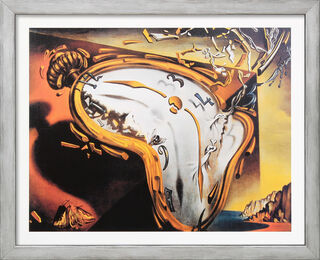Picture "Les Montres Molles", framed


Picture "Les Montres Molles", framed
Quick info
reproduction on paper | framed | glazed | size 26 x 32 cm (h/w)
Detailed description
Picture "Les Montres Molles", framed
High-quality edition on paper. Motif size/sheet size 24 x 30 cm (h/w). Framed in silver-coloured solid wood frame, glazed. Size 26 x 32 cm (h/w). © Demart pro Arte B. V./VG Bild-Kunst, Bonn 1999 Published by UP. Universal Prints, Hamburg 1999.

About Salvador Dalí
1904-1989 - Artist of the century from Spain, the main representative of Surrealism
His provocations shocked the art world, his visions thrilled the crowds. Salvador Dalí was undoubtedly one of the most enigmatic personalities in art history. Whether as a painter, graphic artist, illustrator, sculptor, stage director or writer - Dalí always broke new ground and set standards for existing and future generations.
For Salvador Dalí, painting is the visualisation of his imagination, which is stimulated by a reality he has created himself. For him, dreams and hallucinations are the real world. The subject matter of his works is characterised by constant self-exploration and the influence of Freud's psychoanalysis.
The main representative of Verist surrealism began his training at the Madrid Academy but was expelled from it for his rebellious behaviour. However, he continued to study the paintings of old masters, whose motifs can be found in his own works. His early work was influenced by Cubism and Italian Futurism.
Through Miró's mediation, he joined the Surrealist circle in 1928. There he met Gala, the muse of the Surrealists. She became his partner and the model for numerous paintings.
The versatile artist was not only concerned with painting and sculpture but also with film. Together with Buñuel, he made the short film "Un Chien Andalou" (An Andalusian Dog) in 1929. His first book followed a year later, in which he explained his "paranoiac-critical method".
In 1940, Dalí went to the USA for eight years and worked there mainly in the fashion and advertising industries. Returning to Spain, he professed Catholicism and added more and more religious and mythological themes to his work.
The bizarre forms and figures in his paintings often deviate from reality and are combined with absurd combinations of objects to create a fantastic dream world. Yet despite all this, they possess an astonishing realism. For Salvador Dalí, an essential element of his art and his behaviour was staged provocation.
A movement in contemporary art that developed in Europe and America. Following Sigmund Freud’s psychoanalysis, it seeks the actual reality in the subconscious. Surrealism exploits dreams and intoxicating experiences, as well as hypnotic states as a source of artistic inspiration.
Famous artists and sculptors of this movement are Max Ernst, Salvador Dali, Giorgio de Chirico, Yves Tanguy, Joan Miró and René Magritte.


